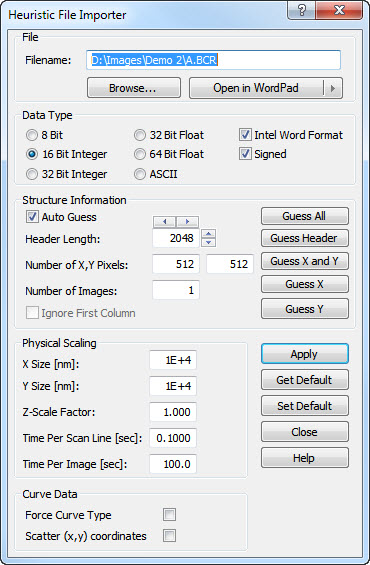
When trying to open a file that is not directly supported by SPIP, the Heuristic File Importer Dialog is activated. You have the option to let SPIP guess the structure or provide SPIP with some information about the format. This way you will be able to read almost any file excluding files containing compressed data. For accurate measurements, it is necessary to enter the correct physical scaling parameters.

This field initially contains the name of the file, which format was not recognized by SPIP. By putting in a name for a file that is recognized you can force SPIP to read the file in a different way. This can be a temporary solution when your microscope vendor has changed the format, for example, included multiple images in the same file. If such a situation occurs, please contact Image Metrology so that we can implement a proper solution.
SPIP currently supports four binary word types in addition to ASCII. It is important that you enter the correct word type and if you are in doubt consult your microscope manual or just try the different possibilities. Most SPM file formats consist of a fixed-sized header describing the image followed by Nx ´ Ny 16 bit signed integers. You will usually be able to distinguish a correctly read image from a wrong.
The binary words are usually in the Intel format. However, if your data source is a UNIX or Macintosh workstation it is more likely that you need to turn off this setting.
By checking the Auto Guess check box you can conveniently have SPIP to guess the structure information whenever the Data Type is modified or a new file is defined. However, if you are repeatedly opening files of a certain structure it might be desirable to keep the structure fixed by turning off the Auto Guess function.
The Header Length is the number of 8-bit bytes in front of the raw data.
The number of X and Y Pixels in the X and Y directions determine the number of pixels in the image. SPIP assumes that the data are produced in a raster scan, i.e., there are Ny scan lines each of Nx points.
In many cases you can successfully let SPIP guess the size of the header and the number of X, Y points. The guess will be based on the Data Type setting and the size of the file.
If you know the number of X, Y pixels you can let SPIP guess the header size so that it fits to the settings and the size of the file.
If you have entered a known header size you can let SPIP guess the number of X,Y pixels that will fit to the settings and the size of the file.
Let SPIP Guess the number of X pixels and keep the header and Y pixels fixed.
Let SPIP Guess the number of Y pixels and keep the header and X pixels fixed.
For quantitative analysis in absolute numbers, it is important that data for the physical dimensions of the image are entered.
The X, Y size should be entered in nanometer, - a future release of SPIP will give you the option to define other units. If your image is representing other units you might enter these in the Image Properties Menu
The Z-scale factor is the factor by which the read pixels should be multiplied in order to achieve the correct height information.
The two timing parameters are important if you want to extract time related information. Sinusoidal 50 Hz noise signal added to the Z-data, for example, can be detected in the Fourier Image and quantified as a 50 Hz noise.
The Time Per Image is usually 2 Ny times the Time Per Scan Line. However, some systems may perform some additional scanning outside the visible scan-line causing the time per image to be larger.
Mark this checkbox if the data present force curves
Mark this checkbox if the data presents scatter data with x,y coordinate pairs.